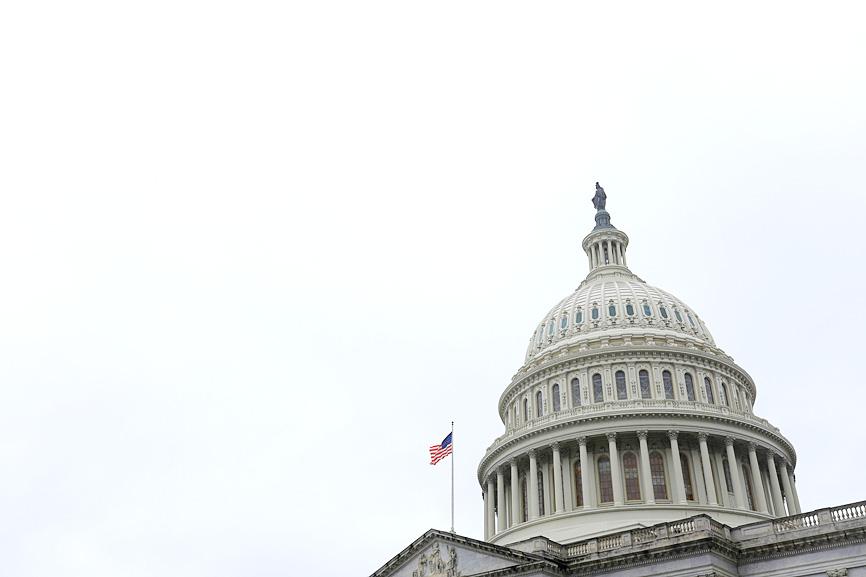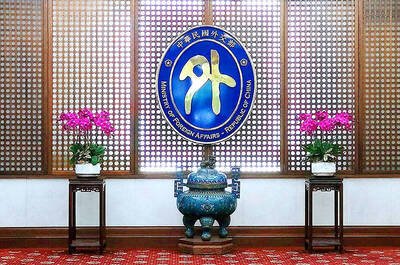The US Senate on Monday passed an omnibus competitiveness bill that includes provisions to enhance military, cultural and diplomatic ties with Taiwan, but obstacles remain in having the bill enacted into law.
The Senate approved the America COMPETES Act by a 68-28 margin after the House of Representatives passed an act of the same name by a 222-210 vote on Feb. 4.
However, the bill approved by the Senate replaced the original content of the America COMPETES Act with that of the US Innovation and Competition Act (USICA), which the senate passed on June 8 last year.

Photo: Reuters
Both bills are aimed at increasing the competitiveness of the US — in particular against China — with a significant emphasis on boosting scientific and engineering innovation, research and development, and production of advanced electronic components in the US.
There was considerable overlap between the USICA and the original contents of the America COMPETES Act, including on regional strategies to counter China.
However, substantive differences also exist in several areas, including economic diplomacy, strategic and diplomatic matters, and multilateral strategies to bolster US power.
The House is not expected to agree to the latest version approved by the Senate, meaning that the two bodies will have to negotiate a reconciliation of the bills they passed into a final version that can get 60 votes in the Senate and pass a divided House.
With respect to Taiwan, both bills generally reiterate US support for Taiwan, recognizing Taiwan as a “vital part” of the US’ Indo-Pacific strategy and a vital national security interest of the US.
They require the US to reinforce its commitments to Taiwan under the Taiwan Relations Act and the “six assurances,” and conduct regular transfers of “defense articles” to enhance Taiwan’s self-defense capabilities, in particular its efforts to develop and integrate asymmetric capabilities.
They both call on the US secretary of state to consider establishing a US-Taiwan cultural exchange foundation “dedicated to deepening ties between the future leaders of Taiwan and the United States,” and contain lengthy provisions on a Taiwan fellowship program to allow government officials to go to Taiwan for two years to learn Chinese.
However, there are key differences.
The House-backed bill calls for negotiations on renaming Taiwan’s representative office in the US — the Taipei Economic and Cultural Representative Office — while the Senate version does not.
It also includes a Taiwan Peace and Stability Act, which focuses specifically on enhancing deterrence measures in the Taiwan Strait, and a Taiwan International Solidarity Act that are not found in the Senate bill.
The Senate bill does call for ending the practice of referring to Taiwan’s government as the “Taiwan authorities” and for ending restrictions on officials of the two sides to interact directly with each other or on Taiwan to display symbols of the Republic of China’s sovereignty.
However, it says these appeals should not be “construed as entailing restoration of diplomatic relations with the Republic of China (Taiwan) or altering the United States Government’s position on Taiwan’s international status.”
No similar disclaimer is found in the House bill.
In another key area of the bills, involving incentives for the production of semiconductors in the US, the two bills offer similar language, but the House bill has been described as more aggressive in creating a new Supply Chain Resilience Program.
Overseas suppliers, such as Taiwan semiconductor giant Taiwan Semiconductor Manufacturing Co, have lobbied for foreign manufacturers to benefit from the measure, but it was not immediately clear if the two bills differed on this point.

The Ministry of Foreign Affairs (MOFA) yesterday voiced dissatisfaction with the Comprehensive and Progressive Agreement for Trans- Pacific Partnership (CPTPP), whose latest meeting, concluded earlier the same day, appeared not to address the country’s application. In a statement, MOFA said the CPTPP commission had "once again failed to fairly process Taiwan’s application," attributing the inaction to the bloc’s "succumbing to political pressure," without elaborating. Taiwan submitted its CPTPP application under the name "Separate Customs Territory of Taiwan, Penghu, Kinmen and Matsu" on Sept. 22, 2021 -- less than a week after China

ALIGNED THINKING: Taiwan and Japan have a mutual interest in trade, culture and engineering, and can work together for stability, Cho Jung-tai said Taiwan and Japan are two like-minded countries willing to work together to form a “safety barrier” in the Indo-Pacific region, Premier Cho Jung-tai (卓榮泰) yesterday said at the opening ceremony of the 35th Taiwan-Japan Modern Engineering and Technology Symposium in Taipei. Taiwan and Japan are close geographically and closer emotionally, he added. Citing the overflowing of a barrier lake in the Mataian River (馬太鞍溪) in September, Cho said the submersible water level sensors given by Japan during the disaster helped Taiwan monitor the lake’s water levels more accurately. Japan also provided a lot of vaccines early in the outbreak of the COVID-19 pandemic,

Kaohsiung Mayor Chen Chi-mai (陳其邁) on Monday announced light shows and themed traffic lights to welcome fans of South Korean pop group Twice to the port city. The group is to play Kaohsiung on Saturday as part of its “This Is For” world tour. It would be the group’s first performance in Taiwan since its debut 10 years ago. The all-female group consists of five South Koreans, three Japanese and Tainan’s Chou Tzu-yu (周子瑜), the first Taiwan-born and raised member of a South Korean girl group. To promote the group’s arrival, the city has been holding a series of events, including a pop-up

A home-style restaurant opened by a Taiwanese woman in Quezon City in Metro Manila has been featured in the first-ever Michelin Guide honoring exceptional restaurants in the Philippines. The restaurant, Fong Wei Wu (豐味屋), was one of 74 eateries to receive a “Michelin Selected” honor in the guide, while one restaurant received two Michelin stars, eight received one star and 25 were awarded a “Bib Gourmand.” The guide, which was limited to restaurants in Metro Manila and Cebu, was published on Oct. 30. In an interview, Feng Wei Wu’s owner and chef, Linda, said that as a restaurateur in her 60s, receiving an